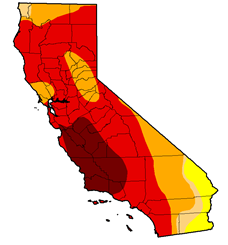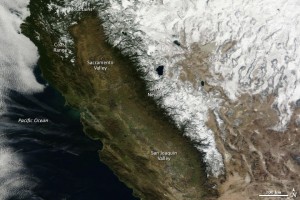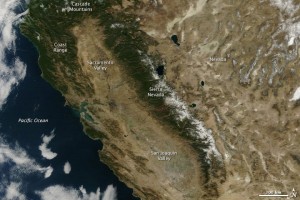
California, Drought, and Climate Change
California and much of the rest of the West Coast have been gripped by drought for the past two years. 90.2% of California has been categorized as being in “severe drought” or worse, and more than two-thirds of the state is experiencing “extreme drought” or worse, according to the most recent report from the United States Drought Monitor. 2013 was California’s driest year since records were first kept in July, 1849. In 2013, San Francisco shattered a nearly century old record for lack of precipitation, experiencing only 5.59” vs the previous low of 9.00” set in 1917 (vs an average of 23.65”). The situation is not getting much better in 2014, as the most recent January ranked as the third driest January on record. Most worrisomely, NOAA and the Drought Monitor report: “all timescales back to 48 months have been drier than average.”
Map of California Drought Conditions.
Yellow indicates “abnormally dry,” dark red is the worst conditions.
No part of California is not affected by dryness or drought.
Courtesy of Drought Monitor
NASA posted images of the same view, a year apart, illuminating the drier conditions and lack of snow covering the Sierra Mountains. Mountain snowpack is about 12 percent the normal amount for this time of year.
(Left: California, January 18th, 2013, Right: California, January 18th, 2014. Courtesy of NASA)
The drought threatens homeland security. Farmers have been hit especially hard. Experts estimate nearly 600,000 acres of farmland in the Central Valley region will lay devoid of crops due to lack of water, and $11 billion lost in annual state revenue from agriculture in 2014. In addition to the economic problems it causes in the industry, farmers, and workers, the drought could threaten the US food supply with food shortages, creating instability in prices and quantity. Drought increases the number and magnitude of forest fires. Homes will be threatened, and firefighters and search and rescue teams potentially overwhelmed.
President Obama toured drought afflicted California this past week, pointing out the link between the water scarcity and climate change: “These actions will help, but they’re just the first step. We have to be clear. A changing climate means that weather-related disasters like droughts, wildfires, storms, floods, are potentially going to be costlier and they’re going to be harsher.”
The American Security Project released a report in 2011, entitled, “Pay Now, Pay Later,” giving a state-by-state assessment of the potential costs of climate change. Our report on California can be found here, and appears especially prescient. One quote from the article sounds as if ripped from a current headline:
California’s agriculture industry— which employs over one million workers and is worth $30 billion—is expected to suffer heavy losses due to rising temperatures and water shortages
as is another line:
The water distribution system, which takes water from the mountains in northern California and distributes it to southern California, relies on the snowpack during the spring and summer months. The system will be further stressed as snowfall decreases throughout the Sierra Nevada Mountains—under a high emissions scenario, snowpack is expected to decrease by 70-90%.
This crisis did not occur without forewarning. In a written testimony presented on April 27th, 2011, before the Senate Committee on Energy and Natural Resources, Dr. Jonathan Overpeck, Professor of Atmospheric Sciences at the University of Arizona, testified the following:
The bottom-line is that New Mexico and the rest of the broad Southwest – extending from California through east Texas and Oklahoma – are at an increasing risk of unprecedented warming, drying and drought, and should prepare accordingly to ensure secure water supplies through this century.
…There is broad agreement in the climate science research community that the Southwest, including New Mexico, will very likely continue to warm. There is also a strong consensus that the same region will become drier and increasingly snow-free with time, particularly in the winter and spring. Climate science also suggests that the warmer atmosphere will lead to more frequent and more severe (drier) droughts in the future. All of the above changes have already started, in large part driven by human-caused climate change.
We hope that you will join us in San Francisco for our event “Climate Change: Risks for National Security” on February 25th where ASP’s General Cheney and General Adams will discuss this and other threats to national security presented by climate change. Click here to see details of the event and to RSVP.
PNPL 2011 California by The American Security Project








[…] California, Drought, and Climate Change […]
[…] California, Drought, and Climate Change […]
[…] California, Drought, and Climate Change […]